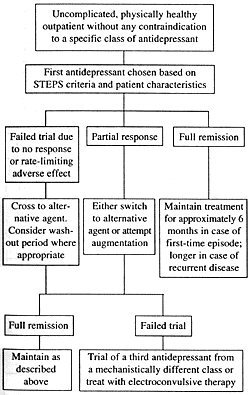|
|
Outpatient Management of Depression
9 - What to Do After the Medication Has Been Selected |
|
|
|
|
|
Treatment begins with the selection of an antidepressant
for the patient. This chapter will review the process to optimally
manage the patient after treatment has begun, including:
- Monitoring the initial phase of treatment to ensure that
optimal response is achieved
- Educating the patient about the drug treatment so the
patient will know what to expect
- Informing the patient about the nature of the illness
and the patient's role in treatment to achieve an optimal
recovery from the illness. That education must include a
discussion of the fact that in many cases clinical depression
is a episodic, recurrent illness.
The goal is to have the patient be an active and important
part of the treatment team to increase the likelihood of the
optimal recovery from the illness.
Initiation and Follow-Up of an
Antidepressant Trial
Optimal treatment starts with appropriate patient education
about the nature of the illness and the nature of the proposed
treatment. That discussion should include:
- The reasons for selecting a specific medication
- When to expect improvement in depressive symptoms
- How that improvement is likely to
manifest itself
- What adverse effects the patient may experience
- What to do in the event adverse effects occur.
A script for patient education has been provided in Chapter
4.
The goal of such education is to help the patient be an active
participant in his/her treatment. That, in turn, should enhance
compliance. The rationale is that patients are more likely
to remain on a treatment even if it causes a nuisance adverse
effect when they know what to expect and what to do if it
occurs. They are also more likely to inform the clinician
if they experience an unexpected effect, thus diminishing
the likelihood of a serious adverse outcome.
The appropriate interval between the initial visit and the
first follow-up visit will typically be either 1 or 2 weeks
depending on how well the patient will likely tolerate the
medication. The patient should be instructed to either call
the clinic or decrease the dose if s/he is having any adverse
effects that are more than a nuisance. At the return visit,
the practitioner can assess the adequacy of the dosing schedule,
determine how well the medication is working, and in the case
of a tricyclic antidepressant (TCA), obtain a plasma sample
to measure the plasma drug level to guide further dose adjustment
(Figure 9.1).191
As discussed in Chapter
8, some antidepressants can cause adverse effects which
can be treatment limiting even though not medically serious.
In such instances, a closer follow-up may be useful to assess
the patient's response, provide reassurance, and take any
corrective steps that may be needed (Chapter
11). An example would be the sedative action of mirtazapine
which occurs early in treatment, often after the first dose.151,178
While this sedation is usually not medically serious, it can
lead to patient discontinuation. The clinician may choose
to deal with that issue by phone if it arises or may wish
to schedule a closer follow-up visit to assess the situation.
During interval visits, patient education about the illness
and its treatment should continue by:
- Responding to any patient questions
- Clarifying issues as needed
- Providing support and encouragement by addressing any
intervening issues (eg, family or employment stresses)
- Assessing the safety, tolerability, and efficacy of the
medication trial.
Obviously, the more severe the episode, the closer the follow-up
should be. Given the fact that all of the current classes
of antidepressants have a delayed onset of clinically significant
antidepressant activity, the clinician may want to see the
markedly ill patient sooner if there is a possibility that
suicidal ideation may emerge between starting the medication
and substantial improvement in the depressive episode.
The interval between follow-up is also dependent on whether
the practitioner needs to see the patient to:
- Assess response
- Titrate the dose
- Deal with the likelihood of treatment-limiting adverse
effects.
The variables that will go into that decision include:
- The personal preferences of the practitioner
- The nature of the patient, including the nature of the
depressive illness
- The specific medication
selected.
| FIGURE 9.1 ó Algorithm
for Treating Patient With Major Depression |
 |
|
|
| FIGURE 9.2
ó Zung Depression Self-Report Rating Scale |
Name _____________________________
Age__________ Sex_______ Date ________
Please put a check in the box that best reflects
how you have mainly felt in the past week for each
question. |
| |
None |
Some |
Mostly |
Always |
| 1. I feel
downhearted, blue, and sad |
|
|
|
|
| 2. Morning
is when I feel the best |
|
|
|
|
| 3. I have
crying spells or feel like it |
|
|
|
|
| 4. I have
trouble sleeping through the night |
|
|
|
|
| 5. I eat as
much as I used to |
|
|
|
|
| 6. I enjoy
looking at, talking to, and being with attractive
women/men |
|
|
|
|
| 7. I notice
that I am losing weight |
|
|
|
|
| 8. I have trouble
with constipation |
|
|
|
|
| 9. My heart
beats faster than usual |
|
|
|
|
| 10. I get
tired for no reason |
|
|
|
|
| 11. My mind
is as clear as it used to be |
|
|
|
|
| 12. I find
it easy to do the things I used to do |
|
|
|
|
| 13. I am restless
and canít keep still |
|
|
|
|
| 14. I feel
hopeful about the future |
|
|
|
|
| 15. I am more
irritable than usual |
|
|
|
|
| 16. I find
it easy to make decisions |
|
|
|
|
| 17. I feel
that I am useful and needed |
|
|
|
|
| 18. My life
is pretty full |
|
|
|
|
| 19. I feel
that others would be better off if I were dead |
|
|
|
|
| 20. I still
enjoy the things I used to do |
|
|
|
|
|
Even a one- or two-step dose titration
schedule can be accomplished without requiring an early return
visit. It does require active patient participation and hence
proper patient education. For example, a patient who is going
to be treated with desipramine can be instructed to start
with 50 mg/day for 3 days, advance to 75 mg/day for 3 days,
and then to 100 mg/day until s/he returns to see the clinician.
The patient with a first-time episode of clinical depression
has a 50:50 chance of having another episode some time in
the future.4,61,98
The likelihood increases if the patient has a strong positive
family history for recurrent depressive illness. The patient
should be educated about the early warning signs of a recurrent
episode to reduce the time between when the patient experiences
the onset of an episode and when s/he seeks help. That, in
turn, hopefully will reduce the severity and the duration
of the episode.
It is useful to explain to the patient with a single depressive
episode that there is a good chance s/he will not have another
one. In the event another episode occurs, there may be years
between the episodes. It should also be emphasized that should
future episodes occur, they should be just as responsive to
medication as the first one was. There is no reason why the
patient should not have a full, productive, and happy life.
The goal is to provide a realistic recognition that there
is a chance of a recurrence without over-emphasizing the risk
and producing the depressive equivalent of a "cardiac
cripple."
At the end of a 4- to-6-week trial of the medication, the
patient's response can be assessed (Figure
9.1). The response can be divided into three categories:
- Full remission
- Partial response
- No response.
These categories have been defined in
Table 5.1. There are several
rating scales that have been developed to provide a reliable
quantification of the severity of the patient's depressive
episode and response to treatment. The one that is most readily
adapted to the primary-care setting is the patient self-report
questionnaire, the Zung Depression Self-Report Rating Scale
(Figure 9.2). This form can be given
to the patient to complete before the clinician sees the patient.
This approach increases efficiency and reinforces patient
education. By completing this form, the patient learns to
think about the severity of his/her illness in a more precise
and quantifiable way. This education can facilitate the patient's
ability to monitor his/her progress.
Duration of Continuation Therapy
If this is a first episode, the patient should remain on
the antidepressant for at least 4 months after remission.4,61,98
This interval is a vulnerable period during which the probability
of a relapse is high if the patient does not remain on medication.
During this phase, the patient should
be seen generally every 1 to 2 months for follow-up medication
checks. During these visits, the practitioner will determine
whether the medication continues to be effective in terms
of maintaining remission and whether it continues to be well-tolerated
and safe. In addition, education about the illness continues
by clarifying any questions that the patient may have. This
education includes a reiteration of the rationale for maintenance
therapy: its purpose and its projected duration.
At the last few visits prior to the termination of continuation
therapy, education should shift to the likelihood of a recurrent
episode. This training can help the patient be more sensitive
to the recurrence of symptoms after the antidepressant medication
has been stopped as discussed below.
Maintenance Therapy
Antidepressant medication can be used to prevent future episodes
as well as to treat current ones. If the patient has had two
previous episodes, there is almost a 90% chance of having
future episodes after medication is discontinued.4,61,98
Even so, the next episode may be years into the future (ie,
every 10 years). Indefinite therapy for all such patients
seems excessive. Instead, each episode may be treated separately.
For patients with seasonal onset to their depressive illness,
they may discontinue the medication during the seasons when
they are not at risk for a recurrence, but initiate therapy
shortly before entering the season at risk.103
Clearly, there are some patients for whom the benefits of
indefinite antidepressant treatment outweigh the downside.
Ideally, the patient should make this decision based on balancing
the following factors: the frequency, severity, duration,
and recurrent depressive episodes versus problems or inconveniences
associated with maintenance antidepressant therapy. Follow-up
visits during active prophylactic treatment may be a number
of months apart, depending on how long the patient has been
on the antidepressant and the nature of his/her depressive
illness.
|

